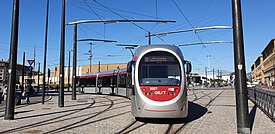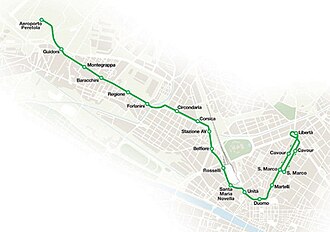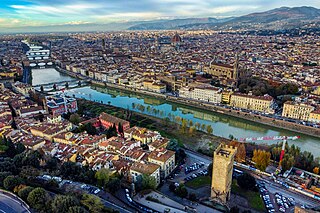
Florence is the capital city of the Italian region of Tuscany. It is also the most populated city in Tuscany, with 360,930 inhabitants in 2023, and 984,991 in its metropolitan area.
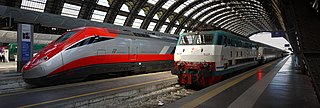
The Italian railway system is one of the most important parts of the infrastructure of Italy, with a total length of 24,227 km (15,054 mi) of which active lines are 16,723 km (10,391 mi). The network has recently grown with the construction of the new high-speed rail network. Italy is a member of the International Union of Railways (UIC). The UIC Country Code for Italy is 83.
Hitachi Rail Italy S.p.A. is a multinational rolling stock manufacturer company based in Pistoia, Italy. Formerly AnsaldoBreda S.p.A., a subsidiary of state-owned Finmeccanica, the company was sold in 2015 to Hitachi Rail of Japan. After the deal was finalized, the current name was adapted in November 2015 to reflect the new ownership.
The Hitachi Sirio is a low-floor tram built by Hitachi Rail Italy, a Japanese-Italian manufacturer of trains, trams and light-rail vehicles. It can be ordered as either one-directional or bi-directional and with a variety of track gauges.

The Genoa Metro is a light rapid transit system consisting of a single line that connects the centre of Genoa, Italy with the suburb of Rivarolo Ligure, to the north-west of the city centre. The service is currently managed by Azienda Mobilità e Trasporti (AMT), which provides public transport for the city of Genoa.

The Florence–Rome railway is part of the traditional main north–south trunk line of the Italian railway network. The line is referred to by Ferrovie dello Stato as the Linea Lenta to distinguish it from the parallel high-speed line. The Linea Lenta is now mainly used for regional services, for the InterCity services — rather than the faster Le Frecce trains — between Florence and Rome and for the majority of freight trains. Some types of passenger train are routed on the line to serve smaller stations not served by the high-speed line or in order to improve traffic flow during peak periods or other periods of congestion.

The Airmobile Brigade "Friuli" is an airmobile brigade of the Italian Army, based mainly in the Emilia-Romagna region. The brigade was part of the 1st Defence Forces Command until it was transferred to the Division "Friuli". The brigade's coat of arms depicts a stylized version of the Rocca di Monfalcone castle near the city of Monfalcone in the Friuli region, where the brigade distinguished itself during World War I. Since 1 July 2019 the brigade is part of the Division "Vittorio Veneto".
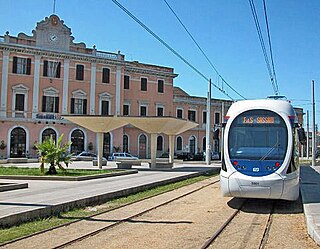
Metrosassari, also called Sassari tramway, Sassari tram-train or Sassari metro-tramway is the commercial name of a tram-train line in Sassari, Sardinia, Italy, operated by the regional public transport company ARST.

Monza railway station is the main station serving the city and comune of Monza, in the region of Lombardy, northern Italy.

Faenza railway station serves the city and comune of Faenza, in the region of Emilia-Romagna, northern Italy. Opened in 1893, it forms part of the Bologna–Ancona railway, and is also a terminus of two secondary railways, linking Faenza with Lavezzola and with Ravenna, and with Florence, respectively.

Firenze Rifredi railway station, or Florence Rifredi railway station, serves the city and comune of Florence, in the region of Tuscany, central Italy. It is the third most important railway station in Florence, after Firenze Santa Maria Novella and Firenze Campo di Marte. It also forms part of the traditional Bologna–Florence railway, and the railways linking Florence with Viareggio, and Pisa and Livorno, respectively.

The Naples tramway network is located within the city and comune of Naples, in the region of Campania, southern Italy. In operation since 1875, the network has waxed and waned in size and vitality over the years, and is now growing once again. It is now 11.8 km (7.3 mi) long, and comprises three routes, known as lines 1, 2 and 4.
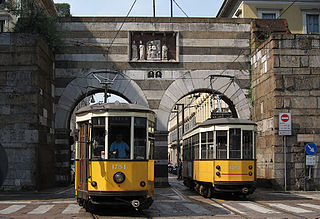
The Milan tramway network is part of the public transport network of Milan, Italy, operated by Azienda Trasporti Milanesi (ATM).

The Turin tramway network is an important part, along with the Turin Metro, of the public transport network of the city and comune of Turin, in the Piedmont region, northwest Italy.

The Lugano tramway network was part of the public transport network of Lugano, in the canton of Ticino, Switzerland, for over half a century. Opened in 1896, the network was progressively replaced by the Lugano trolleybus system by 1959, with one independent line surviving until 1964.
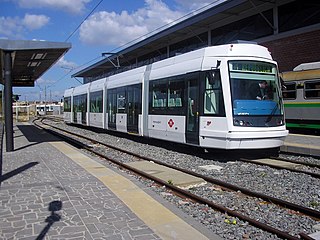
The Cagliari light rail system, commercially known as Metrocagliari, is a two-line light rail system that serves the town of Cagliari and part of its metropolitan area, in Sardinia, Italy. The system was inaugurated in 2008 and has subsequently been expanded to two lines.
The following is a timeline of the history of the city of Florence, Tuscany, Italy.

The Bologna tramway network was an important part of the public transport network of Bologna, Italy. It was established in 1880 and discontinued in 1963.

The Palermo tramway network is part of the public transport network of Palermo, Italy. It consists of four operational light rail lines; three more lines were under planning as of 2015
The Bologna tramway network is a tramway network under construction in Bologna, Italy.
